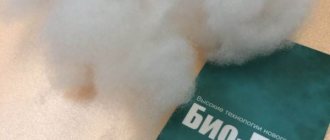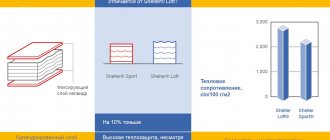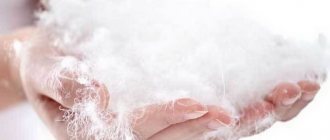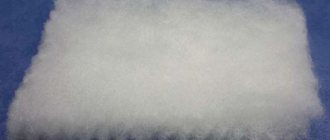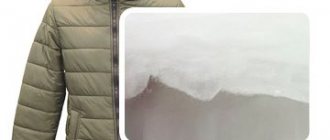Features of fiber production and operation
Manufacturers treat thin polyester threads with silicone to prevent them from sticking to each other. After this, machines weave them together, leaving the structure porous. This is how voluminous canvases are created, which always return to their original state after pressing, washing, pressure and stretching. Thanks to this property, the resulting product is not at risk of caking and loss of characteristics after wear.
Before use, the resulting fabrics are strengthened with spunbond, that is, a special polymer solution. The result is indicators that are unattainable for most known insulation materials.
Thermal resistance – 25.8 kg/sq.m. For example, padding polyester has only 20 kg/sq.m;
Thermal conductivity is only 0.031 W/m.
What is fibertek seal in clothing: properties and characteristics
Taking into account the above values and multi-level tests, the developers guarantee that a person will be comfortable at temperatures as low as -40 degrees. This is confirmed by reviews from customers of the Stayer online store who have experienced the features of this material. In addition to good resistance to frost, owners of clothing in which this filler is used noted a number of useful properties:
Durability. This is due to the fact that down jackets with such insulation do not fall off and do not lose their appearance after washing in a regular washing machine.
Resistance to moisture - the fibers repel water, so in such jackets there is no fear of getting caught in the snow, lying in the snowdrifts or getting wet in the rain.
The optimum ratio of price and quality. Stayer uses high quality raw materials, but does not inflate the price. Domestic production, which eliminates the cost of expensive transportation.
Safety of use. The lining will not catch fire when approaching a fire source; synthetic threads may begin to melt.
Appearance. Due to the fact that the fibertech material does not need to be surrounded by additional voluminous layers, the entire down jacket looks neat. It makes girls look slimmer, and favorably emphasizes the figure of men.
Properties
- high thermal insulation performance. Able to withstand frosts down to minus 40 degrees, humidity does not affect this ability;
- ease;
- softness and plasticity;
- elasticity. Quickly restores the original volume when the load is removed;
- moisture resistance. Siliconized polyester fiber is not affected by moisture;
- wear resistance. The material is very durable;
- breathability. While it retains heat well, fibertek also provides excellent ventilation and does not allow liquid to accumulate inside the product;
- environmental friendliness;
- strength. Thanks to the duplicating fabric, it is very difficult to tear;
- does not absorb foreign odors.
Which is better, Thinsulate or Firetec?
Advantages over other types of fillers (thinsulate, down-feather, padding polyester, holofiber):
- non-toxic. Fybertek does not contain glue or other chemicals (thermal bonding method is used in production) and is treated with natural impregnations;
- hypoallergenic;
- resistance to deformation during operation and washing. Able to quickly restore the original volume - this indicator for fibertek is 10-20% better than for padding polyester;
- has the best thermal insulation properties when compared with other insulation materials of similar density and thickness. The thermal conductivity coefficient of fibertek is more than 60% lower than that of wool felt, and 35% lower than that of cotton wool, and the indicator of the best thermal insulator - still air - exceeds fibertek by only 19%;
- contains polyester fibers that do not absorb moisture and do not reduce the thermal insulation properties of the material. For example, a microfiber such as Thinsulate is more moisture-absorbing, it absorbs moisture and loses these properties;
- quickly removes moisture from the human body;
- does not contain fusible fiber;
- reinforcement with spunbond makes the material more tensile strength, and such a gasket does not allow microfiber to break through the layer of upper fabric;
- unlike other insulation materials, it can be attached only at the seams, without stitching to a layer of outer fabric;
- relatively low cost.
Preparation method
The production technology requires the use of only clean, proven, non-toxic raw materials. In comparison with the main competitors (“Fiber”, “Discend”, “Tony Sailor”, “Ogner”, “Sport Alen”) that produce insulation materials, Stayer products received an advantage at the creation stage, when the developers refused to use them as part of the future fabrics of low-melting fibers. It is their presence in the composition that leads to creasing, clumping into separate lumps and deterioration after washing, especially when using water with a temperature above 30 degrees. But, as housewives well know, in this mode it is almost impossible to put clothes in order after active winter walks. With modern insulation this has become possible.
Stains on a down jacket after washing
Often, after washing, stains form on down jackets. They have different appearances, and therefore the methods of fighting will be different:
if the stains are white (from the powder), then they are removed by thoroughly rinsing or rubbing with a brush; yellow stains due to non-compliance with drying rules. They occur during drying if you do not fluff up the fluff during drying or shake the jacket.
Divorce occurs for various reasons. If they are from powder, then the problem is easily solved, but if they are from improper drying, then a new wash is required.
To avoid such troubles, you need to wash down jackets in slightly heated water with minimal addition of powder. And it is required to dry at normal temperature without exposure to direct rays of the sun and draft. Remember to separate the lumps, otherwise the yellow streaks will only be removed by repeated washing.
What is fibertech filler for down jackets: advantages, comparison with other materials
Determining indicators for selection, advantages:
- Stable breathability, which practically does not change after washing. It provides satisfactory heat exchange, which is necessary for the human body to prevent an increase or decrease in temperature inside. This way, strong gusts of wind are not a problem. This is especially true when practicing extreme sports: snowboarding, alpine skiing.
- Low moisture holding capacity guarantees quick drying and high resistance to weather conditions. At the same time, natural ventilation is not affected. This is a necessary indicator, because the greenhouse effect is very harmful to health. In fiberglass outerwear, the skin does not sweat much, and moisture is absorbed into the pile over time. If your back remains wet for a long time, there is a risk of catching a cold.
- It is safe and environmentally friendly because only natural raw materials are used to make the fabric. This is evidenced by certificates of hygienic compliance. The absence of glue and polymers in the composition of insulation fibers for fibertek clothing indicates that a person will definitely not have allergic reactions from this material.
- The rate of restoration of the original shape, equal to 100%, indicates the unsurpassed elasticity of the canvas. Consequently, products from Stayer always regain their original, presentable appearance.
This is interesting: Remedy for Foot Odor
Application for sewing workwear
Insulation for workwear must have a specific set of qualities that are perfectly combined in fibertech.
The very first criterion that is important for this type of material is thermal insulation . It is to preserve heat that synthetic fibers are primarily used for workwear. At the same time, fibertek allows the skin to breathe without creating a greenhouse effect, which characterizes the second most important quality, namely breathability.
The shape, sewn using fibertek, fits the body, does not impede movement, it is light, comfortable, and flexible. A worker dressed in such a suit is able to perform any physical activity without any problems .
These properties make it possible to use the material for the production of uniforms for traffic police officers, who are forced to stay in the cold for a long time in the winter.
Synthetic fibers fill the uniforms of rescue workers, energy workers, and tourists.
Fibertek is also used for sewing equipment for firefighters, metallurgists, and welders. The insulation of workwear for workers who deal with fire is produced with the addition of special fire-resistant additives . These substances artificially increase the melting point of the fiber.
Another modification of fibertek is a laminated top sheet, which makes the insulation not susceptible to thermal radiation from the outside.
Material treated with silver-based antistatic agents will be the best alternative to cold and massive batting and similar insulation in the form of oil workers, gas service workers, gas station personnel and other employees working in professions where static electricity can pose a real threat to life.
Simple operating rules
To tidy up our products, they can be washed by hand or in a washing machine on a delicate cycle up to +40 degrees without spinning and drying. It is not recommended to use chlorine-containing substances as detergents. Also, you should not go to a dry cleaner - there may be an unpredictable reaction of the materials to the products used there. By following these simple recommendations, you will maintain the original appearance of your winter equipment for a long time.
The jacket dries very quickly, so you don’t have to worry about missed workouts and walks.
How to wash a down jacket by hand
If you cannot trust your favorite jacket to a washing machine, then you will be interested in learning how to wash a down jacket by hand. There are also some rules that should not be broken:
Everyone knows that collars, pockets, elbows and cuffs get most dirty. For this reason, these areas require a lot of work. Pour a little shampoo or liquid powder onto them and gently wipe with a brush, then remove the foam with water; If you decide to wash the down jacket completely, then place it vertically so that the filler absorbs less moisture. Moisten the fabric, wipe dirty areas with a sponge or brush with soap, and rinse the jacket using a shower whose jets are not directed directly, but tangentially;
Jackets with down inside should be dried on a dryer, away from the sun and radiators. This is a serious point, because otherwise the fluff becomes brittle due to the influence of high temperature. While drying, shake the jacket from time to time, then you will not have any lumps under the lining, that is, the filling will dry evenly.
Clothes made from fibertech material
Insulation is used in cases where a combination of lightness and thermal insulation is necessary:
in climbing equipment;
in sports equipment;
for small children who would be uncomfortable in a padded jacket;
in the overalls of traffic police officers, firefighters and other professions associated with prolonged exposure to fresh air.
The peculiarity of fibertek insulation is how many degrees of frost it can be used. It will protect at an air temperature of -40, so this is the best option for those who cannot get sick:
for responsible employees;
Additional Applications
The fibers are used to make blankets and pillows. This is done due to the fact that the products acquire the following qualities:
do not lose their elastic shape;
do not have conditions for the reproduction of insects - bedbugs, moths;
Because of these properties, the material is used to make bedding for small children and cradle sides.
Before buying outerwear or everyday items, find out about the qualities of the insulation materials used. Fibertek is a modern, innovative product; products made from it will serve you for many years.
Use in other areas
Thanks to its properties, fibertek has found application in both the household and furniture industries..
Hygiene, environmental friendliness, and safety make canvas an indispensable material in the production of furniture.
High tensile strength, resistance to damage and compression, easy care allow the use of a synthetic substitute for natural down as a flooring material and filler for upholstered furniture, pillows, and toys .
Polyester fibers are perfect for arranging a sleeping area. Moreover, they can be used both in ordinary sleeping bags and in expensive pieces of upholstered furniture.
Insulation in clothes. What are there and which is more practical and warmer?
Once upon a time, children's overalls were made exclusively from raincoat fabric and padding polyester. But experience has shown that jackets and overalls made of thick synthetic padding quickly deteriorate: they clump when washed, do not keep warm, and the body in them, as a tourist or athlete would like, does not breathe, but fogs up. Sintepon conducts air poorly and retains heat poorly.
Synthetic winterizer was replaced by: holofiber, Thinsulate, Fibertek... Which to prefer?
The advantage of synthetic insulation is that they are hypoallergenic, they do not harbor microorganisms (mites, etc.), and clothes with various “fibers” (“fiber” is translated as “fiber”) inside hold their shape better and do not deform from washing, Keeps you warm and doesn't let cold air in.
So, let's deal with insulation without going into highly scientific jungle.
When you see a new, unfamiliar name, don’t rush! The manufacturer, trying to capture the attention of the consumer, comes up with its own (trade) names for insulation materials.
Consider the label on the jacket or overalls. Don’t be surprised if you see the inscription: “insulation – polyester 100%”. And where, you know, is that “fiberskin” or “polyfiber”?
Almost any synthetic insulation consists of polyester fibers. Thus, on the label you will read what the material for the insulation is made of, and more detailed instructions or a sales consultant should tell you what the name of the insulation itself is, what technology it is made of, and what this technology provides. Products from reputable companies have a special booklet where all the materials are described in detail and their qualities are indicated.
80% of childhood colds are not to blame for the immune system, but for parents who do not know how to dress their child. For example, a child who often suffers from colds should never be re-wrapped, and it is absolutely forbidden to wear thick hats and tie tight scarves.
Not a single seller will be able to explain to you whether your child will freeze in just such clothes. All new generation synthetic fillers work on the same principle: they retain heat well. Look for (ask) an indicator of the permissible temperature (up to -10° or up to -40°).
Remember that it is not the insulation that heats, but the air in its cavities. The lighter the fibers, the more cavities inside, the lower the temperature at which these clothes can be used. The best thermal insulator is air.
The label on a real down jacket should say “down”. This means that the fluff inside is eider, swan or goose. 100% “down” is quite rare. Most often, feathers are added to it and written “feather”. If the label says “cotton”, this is not a down jacket, but just a lined jacket. The inscription “wool” indicates that there is wool batting inside this jacket, and the word “polyester” or “waltern” refers to padding polyester or its modern varieties.
This is interesting: Salo in Belarusian style at home
Sintepon is divided into two types: old (dense) and new (hollow). Both are made from polyester fibers. Bonding of fibers to each other is carried out thermally. Previously, synthetic winterizer was laid in parallel layers. Because of this, it had very low performance in terms of heat conservation and moisture conductivity. Nowadays, dense padding polyester (thick, adhesive) is used only in cheap products. In the new padding polyester, the fibers are not glued together, but seem to be held together with the help of silicone needles. This insulation is more durable and does not lose its shape. But still, synthetic winterizer continues to yield to modern inventions. After exposure to sweat and washing, it loses up to half its thickness. And it is not suitable for cold winters - maximum, for temperatures down to -10°. Care: wash at 30°C using only soft powders that do not contain bleaching agents; do not soak or bleach. Thinsulate
It is considered one of the best insulation materials at the moment; its heat-saving properties are equal to down. Consisting of very fine fibers that retain heat excellently, overalls and jackets made with Thinsulate are light, thin and warm. It does not deform when washed, it can warm you in severe frosts, provided that the person moves, preferably actively. Thinsulate clothing is made for athletes, oil workers, and climbers. Thinsulate clothing is usually not cheap. Permissible temperature range for Thinsulate: up to -30°. Care: machine wash with spin at 40°.
Holofiber, fiberskin, fibertech, polyfiber, isosoft...
Synthetic insulation made from fibers shaped like balls, springs, etc. Balls, spirals or springs do not communicate with each other and contain cavities, so the product holds its shape well. For a small price you buy a good overall that can withstand temperatures down to -25°. Care: machine wash with spin at 40°.
Kerry - children's overalls made of polyester (isosoft).
A luminary among insulation materials. Lightweight, durable, withstands severe frosts, restores shape after creasing. The down of waterfowl has a natural lubricant that prevents moisture from being absorbed. The best down: eider down, followed by goose. Duck down clothing is the cheapest and is not intended for cold weather. A properly sewn item lined with natural down weighs no more than half a kilogram and, when folded, can easily fit into a standard plastic bag. Unfortunately, down is a very allergenic material, an ideal breeding ground for mites. Down clothes take a long time to dry. If you buy a down jumpsuit (envelope) for our Ural winter (not for moving to the north), remember that an active child outside will definitely be hot in it at temperatures above -15°.
Care: to ensure that the product retains its appearance longer, resort to full washing of the product less often. It is recommended to wash on a soft cycle with a detergent without bleach at 30°. Machine washable. After washing, immediately dry and “break” the pockets with fluff so that it does not fall off. You can't iron it. Only machine drying for several hours at low temperatures is recommended.
Or the so-called sheepskin. Very durable, wear-resistant material. Microbes do not like wool, so it is considered a hypoallergenic insulation. Retains heat perfectly down to -25°. It happens that the overalls are equipped with a removable sheep wool lining, this is convenient for suspicious parents who think that the child is cold. The lining allows you to turn the jumpsuit into a demi-season option. Due to their considerable weight, sheepskin overalls are now produced mainly only for children under one year old.
Care: clothes with sheepskin can become deformed from washing, so it is better to dry clean them.
As a conclusion:
In general, the choice is yours. Remember that you are not buying children's winter overalls for yourself, but for your baby, who should be comfortable in his favorite hiking outfit.
Feather and down fillings
Natural insulation with high thermal insulation properties. It compresses well and restores its shape just as easily, very warm. Usually the ratio in clothing is 80% down and 20% feather, sometimes you can find 70% and 30%, respectively.
This is interesting: The secret ingredient that is added to milk to stop it from souring
Disadvantages - this insulation gives outerwear curvaceous shapes. After improper washing and drying, some of the filler gets through the holes in the seams.
Thinsulate
You can only talk about this insulation with the prefix the most: - the warmest - one and a half times warmer than down and other synthetic insulation; - the thinnest - microfibers are 50 times thinner than a human hair; - the lightest - does not weigh down clothes at all; - the most wear-resistant - the manufacturer of this insulation claims that the outer fabric of clothing wears off earlier. Thinsulate can be washed perfectly at 40 degrees with a spin in the washing machine.
Thinsulate has no disadvantages.
Recommendations for product care
Another advantage of fibertek and shelter insulation is that it does not require any special conditions of operation, washing and storage. If for some reason the manufacturer has not indicated how to care for a product with this filler, you can follow the standard instructions for other synthetic materials - holofiber, padding polyester, etc. Read about an orthopedic sleeping pillow in this article.
How to wash in a washing machine
How to wash the product:
- The material can be washed by hand and machine in the “Delicate” mode.
- The water temperature should not exceed 40°C.
- It is preferable to use conditioning gels rather than powders and oxygen bleaches.
- It is prohibited to use bleaches and stain removers containing chlorine on fibertek.
- Spin must be set at no more than 500 rpm.
To straighten it, just shake off the clothes a couple of times and hang them on hangers to dry away from direct sunlight and heating devices.
It is not recommended to take jackets and down jackets made of fiberglass to the dry cleaner - aggressive chemical solutions can irreversibly damage the material.
Fibertek
Another modern insulation material is Fibertek, which is produced by the Republic of Belarus. It is able to withstand temperatures down to -40 C, and in conditions of high humidity it does not reduce its thermal insulation properties at all. This insulation is stronger than its direct competitors and is resistant to repeated washing and drying. Environmentally friendly and completely safe. Fibertek is a lightweight, warm, moisture-resistant and breathable insulation material, which is why it is often used in the manufacture of sportswear and outerwear for climbers.
Fibertech has no disadvantages.
Cleaning a down jacket without washing
In order not to think about how to dry the down jacket after washing, minimize its contact with moisture and dirt. Of course, this cannot be completely avoided, but if a small stain appears on the jacket, there is no need to wash the entire down jacket. Treat the area with soap, scrub with a brush and rinse.
Traces of grease can also be cleaned without washing. This requires salt and vinegar (½ tbsp and 1 tbsp). Mix the ingredients with 0.5 liters of slightly warmed water, clean the area with dirt and wipe it with a clean cloth slightly moistened with water.
Waltherm
Modern high-tech insulation, developed and patented in Italy. It is used to insulate not only everyday outerwear, but also special clothing. Waltherm has excellent thermal insulation properties. Good air permeability. Retains its shape regardless of the washing method. Dries quickly.
Waltherm has no disadvantages.
In the Sympathy store you can buy a down jacket or a warm jacket with any of the described insulation.
